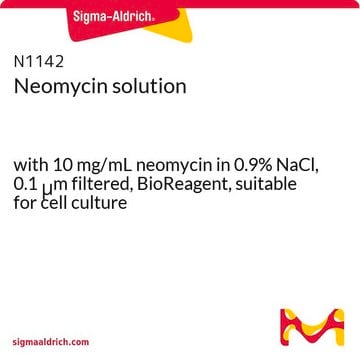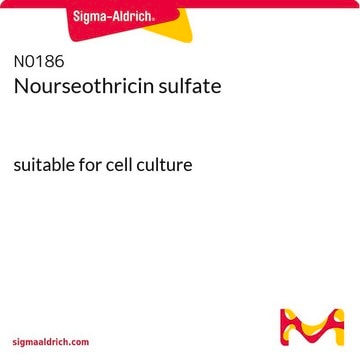A1720
G 418 disulfate salt
powder, non-animal origin, suitable for cell culture, BioReagent
Sinónimos:
Antibiótico G418
About This Item
Productos recomendados
product name
G 418 disulfate salt, powder, BioReagent, suitable for cell culture
product line
BioReagent
form
powder
optical activity
[α]/D (Specific Rotation: +104.4o (c=0.3% in H2O at 26oC))
potency
≥720 μg per mg (Dried basis)
mol wt
692.7
packaging
pkg of 1 g
pkg of 25 g
pkg of 5 g
technique(s)
cell culture | mammalian: suitable
color
white to off-white
solubility
H2O: 100 mg/mL (As a stock solution. Stock solutions should be stored at 2-8°C. Stable at 37°C for 8 days.)
antibiotic activity spectrum
Gram-negative bacteria
mode of action
protein synthesis | interferes
storage temp.
2-8°C
SMILES string
OS(O)(=O)=O.OS(O)(=O)=O.CN[C@H]1[C@H](O)[C@@H](OC[C@@]1(C)O)O[C@H]2[C@H](N)C[C@H](N)[C@@H](O[C@H]3O[C@H]([C@H](C)O)[C@@H](O)[C@H](O)[C@H]3N)[C@@H]2O
InChI
1S/C20H40N4O10.2H2O4S/c1-6(25)14-11(27)10(26)9(23)18(32-14)33-15-7(21)4-8(22)16(12(15)28)34-19-13(29)17(24-3)20(2,30)5-31-19;2*1-5(2,3)4/h6-19,24-30H,4-5,21-23H2,1-3H3;2*(H2,1,2,3,4)/t6?,7-,8+,9+,10+,11-,12-,13-,14+,15+,16-,17-,18+,19-,20+;;/m0../s1
InChI key
UHEPSJJJMTWUCP-NKCAIAFTSA-N
¿Está buscando productos similares? Visita Guía de comparación de productos
Categorías relacionadas
General description
Application
Biochem/physiol Actions
Caution
Preparation Note
Other Notes
signalword
Danger
hcodes
Hazard Classifications
Resp. Sens. 1 - Skin Sens. 1
Storage Class
11 - Combustible Solids
wgk_germany
WGK 3
ppe
Eyeshields, Gloves, type N95 (US)
Certificados de análisis (COA)
Busque Certificados de análisis (COA) introduciendo el número de lote del producto. Los números de lote se encuentran en la etiqueta del producto después de las palabras «Lot» o «Batch»
¿Ya tiene este producto?
Encuentre la documentación para los productos que ha comprado recientemente en la Biblioteca de documentos.
Artículos
Antibiotic kill curve is a dose response experiment in which mammalian cells are subjected to increasing amounts of selection antibiotic
Antibiotic kill curve is a dose response experiment in which mammalian cells are subjected to increasing amounts of selection antibiotic
Antibiotic kill curve is a dose response experiment in which mammalian cells are subjected to increasing amounts of selection antibiotic
Antibiotic kill curve is a dose response experiment in which mammalian cells are subjected to increasing amounts of selection antibiotic
Protocolos
Determine optimal antibiotic concentration for stable cell lines, ensuring efficient selection in transduced cells.
Determine optimal antibiotic concentration for stable cell lines, ensuring efficient selection in transduced cells.
Determine optimal antibiotic concentration for stable cell lines, ensuring efficient selection in transduced cells.
Determine optimal antibiotic concentration for stable cell lines, ensuring efficient selection in transduced cells.
Nuestro equipo de científicos tiene experiencia en todas las áreas de investigación: Ciencias de la vida, Ciencia de los materiales, Síntesis química, Cromatografía, Analítica y muchas otras.
Póngase en contacto con el Servicio técnico






